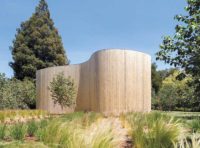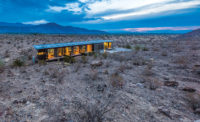The residential architecture of Atherton, California, is nothing if not eclectic. Peeking out from behind the town’s ubiquitous fences are modernist glass boxes, French chateaux, and Italianate villas. But a just-finished house in this leafy Silicon Valley suburb, by San Francisco–based architect Craig Steely, defies stylistic categorization. The enigmatic one-story structure on a long and skinny lot is defined by a sinuous, almost windowless wall clad in vertical cedar planks. Although about half of the 5,900 square feet behind the curving enclosure are sheltered under flat roofs, the architect has dubbed the residence the Roofless House, since the remaining space is devoted to courtyards and is open to the sky.
Additional Content:
Jump to credits & specifications
Steely’s aim was to create an “escape pod” for his software engineer client, who hoped to take advantage of the temperate Bay Area climate through as much outdoor area as possible, but who also wanted to limit her views of the surrounding architectural hodgepodge. The solution was to replace the typical Atherton perimeter fence with the 14½-foot-tall wood wall, but pull it well inside the boundaries of the half-acre property.
The gracefully snaking element, supported by a steel frame with wood-stud infill, defines a house entered through a 7-foot-square glass pivot door into a foyer and approximately 100-foot-long circulation spine. The living areas open off this space, with three generous courtyards interspersed among them. Steely introduced the curves to the otherwise “conventional” plan, he says, as a means of selectively editing out undesirable views and instead directing attention upward, toward the clouds and the tops of nearby mature oaks and redwoods.
The result is a house that is insular but not hermetic. The rooms are light and airy, and flow easily into the courtyards through oversized sliding glass doors. The white-painted drywall ceilings seemingly float above the wood planks that clad not only the curving enclosure’s outward-facing facade but also serve as the wall surface for the courtyards and interior living spaces. The travertine floors, meanwhile, continue into the courtyards, although there the pavers are supported on pedestals and are ungrouted, so that rainwater readily drains. These outdoor spaces include drought-resistant river birch trees, whose slender trunks extend through circular openings in the stone, creating the impression, says Steely, that the trees are growing indoors.
With such combinations of nature and architecture, curving and rectilinear, and spaces that are open and closed, Steely has created an inventive house that ingeniously screens out its less remarkable neighbors, while framing the sky and inviting the sun and breezes inside.
CreditsArchitect: Craig Steely Architecture 8 Beaver Street, San Francisco CA 94114 415 864 7013
Personnel in architect's firm who should receive special credit: Lead: Craig Steely AIA Project team: Luigi Silverman, Ryan Leidner, Toon Kantharoup, Anastasia Victor
Engineers Structural: Strandberg Engineering Geotechnical: Murray Engineers Civil: Lea & Braze
Consultants Arborist: Michael Young Landscape architect: Elias Gonzales Landscape contractor: Siteworks
General contractor: Drew Maran Construction
Photographer: Darren Bradley |
SpecificationsExterior Cladding Wood: Western Red Cedar
Roofing Material: TPO membrane roof
Windows Metal frame windows and sliding doors: Fleetwood
Glazing Glass: Collier Windows
Doors Entrance Pivot door: Fleetwood Wood doors: flush frame custom western red cedar clad by contractor
Hardware Locksets: Columbo Pulls: integrated by cabinetmaker
Interior Finishes Cabinetwork and custom woodwork: Drew Maran Construction Paints and stains: Benjamin Moore, Cabot Paneling: Western Red Cedar Floor tile: Travertine slabs, New Marble Company
Lighting Interior ambient lighting: Artimede Downlights: Elco Exterior: Bega
Plumbing Shower: Kohler Faucets: Hans Grohe Sinks: Duravit Toilets: Toto |















